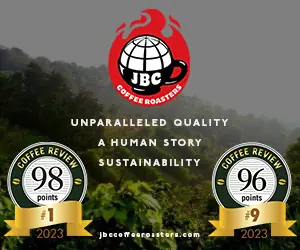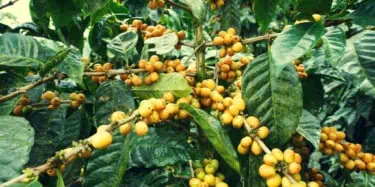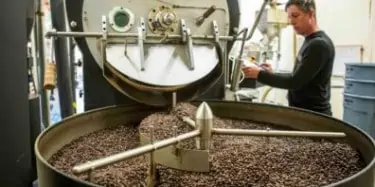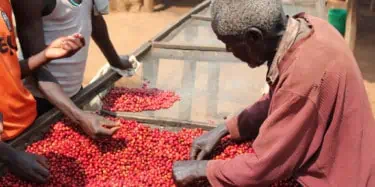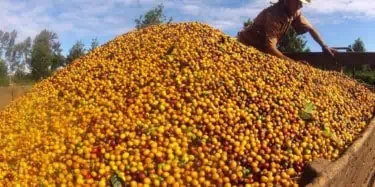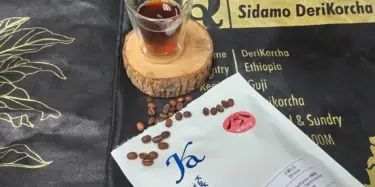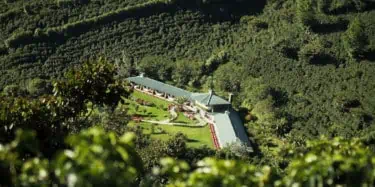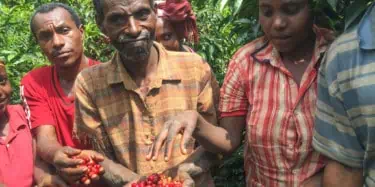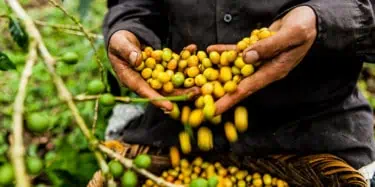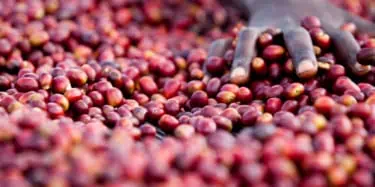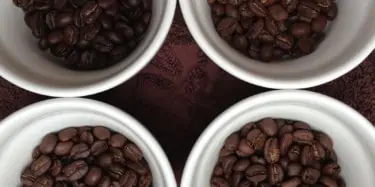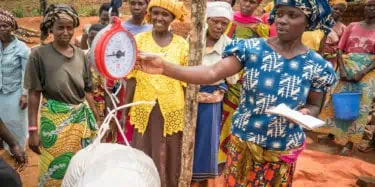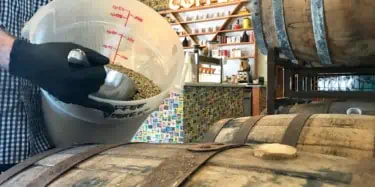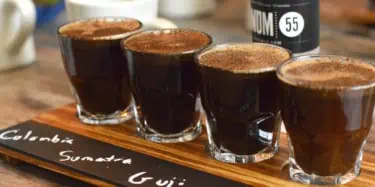Every year in November, we put out a call for special coffees that roasters around the world are featuring for the holidays. It's always a surprise and a delight to discover what surfaces during this weeks-long cupping. And what we learn never fails to be compelling in multi-faceted ways. Some roasters approach seasonal offerings by composing creative, often unique, blends, while others prefer
Tasting Reports – Most Recent
Coffee Review has published more than 250 monthly coffee tasting reports since February 1997. The most recent tasting reports appear below in reverse chronological order. You may narrow your search by category from the main navigation drop-downs or by using the key word search feature that appears in the page header. The content in tasting reports and associated reviews was correct at the time of publication but may not remain accurate over time.
“Big-Bean” Coffee Varieties: Novelty, Scarcity, and Atypical Sensory Pleasures
Among the hundreds of coffees we review each year at Coffee Review, a very small percentage represent what we've come to affectionately call "big-bean" varieties, coffee from tree varieties that produce beans that are dramatically larger than average. The most common of these are Pacamara, Maragogipe and Maracaturra, though there are some even more obscure varieties whose beans are also
Mountain States Coffee Roasters: High Elevations, Classic Coffees
In 2017, Coffee Review began exploring the vibrant roasting scenes in various regions of the U.S., beginning with last year’s popular tasting report on coffees of the American Southwest. This year we take a look at roasters in the U.S. mountain states: Colorado, Idaho, Montana, Utah, and Wyoming. We received samples from all five states. Of the many lovely and interesting coffees among them, the
The New (and Old) Instant Coffees: Convenience Aspires to Quality
It sounds easy enough. Brew the coffee, take out the water, keep the stuff that’s left, package it, and let the consumer put the water back in later. Coffee … instantly. But judging from the 24 soluble coffees we tested for our September tasting report, it isn’t quite as easy as it sounds. It has always been difficult to judge whether the generally dreadful quality of instant coffee sold in
Natural-Process Espressos: Fruit and Chocolate Exalted
I recently led a tasting of fine coffees at a consumer event. Only one of these coffees was natural-processed, i.e., had been prepared at the mill by drying the coffee seeds or beans inside the whole fruit. The other samples were all washed coffees, processed by drying the beans after the fruit skin and flesh had been removed. The washed method is the traditional norm for fine coffee in most
Cold-Brewed Black Coffees: Quality in a Can?
As we sweat our way into summer 2018, enjoying coffee chilled on ice is peaking as the latest specialty coffee trend. Espresso, of course, has long appeared in various cold-blended café concoctions like frappés and smoothies, as well as in bottled ready-to-drink (RTD) beverages heavy on sweetener, milk and flavorings. But this latest cold coffee trend differs from those earlier products by
African Great Lakes Coffees: Burundi, Rwanda, Uganda, Congo, Tanzania
The countries whose coffee regions nestle around the Great Lakes of Central Africa—Rwanda, Burundi, and key growing areas of Uganda, Tanzania, and the Democratic Republic of the Congo—make appearances in the news cycle more often for conflict than for coffee. But these countries are also longtime coffee-producing lands that have, within the last 10 years or so, emerged as important sources of
Coffees from Brazil: Chocolate, Simplicity and Some Surprises
For more than 150 years, Brazil has produced more coffee than any other country in the world. Coffee prices worldwide fall and rise on the slightest whisper of good news or bad news about Brazil’s next coffee crop. Brazil also is among the world’s most technologically advanced coffee producers. Nevertheless, for buyers of high-end single-origin coffees, Brazil shrinks to something smaller than,
Women in Coffee: Why It Matters That “She’s the Roaster”
Last summer, we began our exploration of women's roles in the complex coffee supply chain by looking at the work of farmers—women who work in coffee production as pickers, managers, members of cooperatives, and owners of small farms. In this month's report, we turn our attention to those women who are crucial in the next step of the supply chain: turning green coffee into roasted. We structured
Value Coffees: Searching for the Exceptional at Everyday Prices
At Coffee Review, we often feel conflicting impulses and pressures in regard to coffee retail prices. On one hand, we feel strongly that high retail prices are essential to support producers as well as to honor our commitment to coffee as an extraordinary beverage. On the other, we want to be inclusive and recognize that many readers may not choose to pay a premium for brilliant microlot
Blending Coffees: Craft, Intuition and Thematic Riffs
Blending any two or more things together is a curious and complex act. In winemaking, grapes are often blended to combine extremes in character while simultaneously softening each. Foods may be blended for contrast: Lemon and butter combined, for example, make a classic sauce for pasta or fish that is both richly creamy and tart, a flavor profile that a single food can’t provide. Coffee is an
Top 30 Coffees of 2017
We are pleased to present our list of the Top 30 Coffees of 2017, Coffee Review’s fifth annual ranking of the most exciting coffees we reviewed over the course of the past year. Coffee Review’s goal, as always, is to celebrate coffee roasters, farmers and mill-owners who make an extra effort to produce coffees that are not only superb in quality but also distinctive in character. In particular,
2017 Holiday Gift Coffees
Each year, we ask roasters to send us exceptional coffees available only during the holidays, coffees that might make particularly gratifying gifts or splurges for coffee-lovers. In past years, approaches have ranged from particularly fine lots of classic coffees that roasters reserved for the holiday season, to rare and often expensive seasonally available micro-lot coffees, to ingenious and
Organic-Certified Coffees from Africa: Benefits, Challenges, Complexities
Certified organic coffees must be propagated, grown, processed, transported, stored, and roasted without contact with synthetic chemicals—particularly without contact with pesticides and herbicides. The certification process (carried out by a variety of organizations operating inside a common framework) is lengthy, thorough, rather expensive, but apparently reliable and free of abuse. The use of
The New Nicaragua: Direct Trade Coffees Rule
When we first reported on coffees from Nicaragua, in 2004, the overarching theme was economic development. Specialty coffee was viewed as a way of opening access to economic and social benefits for Nicaragua’s many small- to medium-holding coffee farmers, most of whom had been decimated by the global drop in coffee prices during 1999-2003, and prior to that, by the long war that isolated the
Gesha Coffees 2017: Still Pricey, Still Amazing
I was at one of the Specialty Coffee Association’s Re:co Symposia a couple of years ago, where Jay Ruskey of Goodlands Organic, the pioneer of California coffee-growing, was displaying fresh branches of two varieties of coffee trees at his table outside the meeting rooms. Some of the branches were from the respected mainstream Caturra coffee variety, which is producing some very nice coffees on
Darker-Roasted Coffees: Confessions and Amends
Those readers sensitive to language and to shifting, overlapping tastes in the coffee world may have noticed the nuance in the title of this report: “darker-roasted” coffees rather than “dark-roasted.” When titling this report we wanted to avoid encouraging a polarization between those coffee drinkers who prefer at least a little (perhaps a lot) of the bittersweet pungency promoted by darker
Holding Up (More Than) Half The Sky: Coffees From Women Producers
Mao Zedong’s famous statement that “women hold up half the sky” became central to the zeitgeist of the Western feminist movement of the 1960s and ‘70s, when identity politics began to foreground the plight of women—economically, socially and politically—both in the U.S. and abroad. Regardless of one’s position on the merits of focusing on gender-based affiliations versus shared values as tools for
Aged, Casked and Cured: Innovations in Green Coffee Conditioning
Green, unroasted coffee beans are porous and absorbent. As anyone in the industry knows from painful experience, green beans easily pick up odors from almost anything in their environment — paints stenciled on coffee bags, for example, concrete floors, petroleum residue in shipping containers, cardamom stored in the same warehouse. But where there is a problem there also may be an opportunity.
Exploring Roasters in the American Southwest
For Coffee Review’s monthly tasting reports we typically focus on coffee-producing countries or regions, or certain tree varieties or processing methods, or innovations that arise from the creativity of today’s specialty coffee world. It’s less often that we look at roasters, collectively, by geographical location. But this month we decided to focus on roasters of the Southwestern United States,





